Vision
What is your vision for facilitation in 2025?
Employment & Topics
Where does facilitation happen?
Welcome to the third edition of SessionLab’s
State of Facilitation report.
Read on for essential information and expert insights on what is changing in the world of facilitation and workshop design.
1050 people took the time to fill out the State of Facilitation survey this year: thank you! Here you will find results, divided into 9 sections.
For each section you will find aggregated data (What? ), and commentary by experts from different fields involved in facilitation, such as leadership training and learning design (So What? ). Their role is to guide readers through the material and help make sense of it.
Ultimately, the value of this report is in what you decide to do with its contents. How will it inform, or even change, your practice? We’ve added some reflection boxes along the way, with space for your thoughts and action plans (Now What? ).
If you want to fill in the reflection spaces while you read, and save them for future reference, download the report in PDF format below. If you prefer to read this document online, we invite you to take a moment to think about what actions you might want to take in your own practice by jotting down some notes when you meet the Now What? reflection cards.
We’d love to know how this report informs your practice. Follow SessionLab on Linkedin and Instagram and take part in our #FacilitationForward campaign.
3rd edition
1050 respondents
78 countries
Answers in 7 languages
What is your vision for facilitation in 2025?
Where does facilitation happen?
In-house facilitation
What was it like to facilitate in 2024?
What is in facilitators’ toolboxes?
How are facilitators using GenAI?
How do facilitators keep learning?
Who is facilitating and where?
Before we jump in, a word of caution:
To collect responses we reached out to our networks, colleagues, business partners, and friends. We did our best, but inevitably that reach is limited. A majority of responses reached the survey through our own channels, such as the SessionLab newsletter. This may help explain certain aspects of the data we’ve collected, especially when it comes to overrepresentation of European and North American responses.
Help us reach beyond our bubble in the next edition by joining in and reaching out to your networks. Leave your email below and we will let you know as soon as survey for 2025 is open.
Prefer to download the report?
If you prefer to download the report in PDF format, leave your email here to receive it in your inbox! You’ll also receive SessionLab’s facilitation newsletter and get updates about the next survey too!
Facilitation in 2025 is all about finding the balance between the human and technological aspects of the craft. Facilitators must know how to stay in the moment, present and aware of human dynamics. At the same time, increased use of specialized software and AI assistance indicates the growing importance of technological proficiency, with facilitators who embrace these tools gaining a competitive edge. Technology can enhance facilitation, but how to keep it from being a distraction?
The silos between online vs in person facilitation have broken down. With more teams and projects happening in distributed locations, facilitators are called in to help teams keep aligned, wherever they are. Facilitation has become multi-modal, operating across hybrid formats, combining in-person, online, and asynchronous sessions. Hybrid facilitation in particular requires extra expertise and resources for maintaining engagement across diverse participant groups.
The length of a typical session has shortened since pre-Covid days, from half a day to 90 minutes. Facilitators must adapt to shortened attention spans, deliver impact quickly, and get creative with working in modules or series of sessions. It can be challenging to identify what can be done in small interventions and what truly requires more space and time.
Facilitation skills are spreading within companies, with more professionals working inhouse. Larger organizations in particular are discovering the benefits of having team leaders and managers put facilitation skills at work in regular meetings and collaborative projects. Learning and development departments are leading the way in promoting facilitation as an essential leadership skill. Read more in our special focus on inhouse facilitation below!
As facilitation gains recognition as a workplace skill, the need for training in general facilitation skills is rising. Interest is growing for introductory courses sharing facilitation basics that can make the difference in any meeting or event. This represents an opportunity for facilitators to lead by example and upskill other professionals.
Facilitators are often the ones calling attention to cultural sensitivity and matters of diversity, equity and inclusion (DEI). When asked for their vision for the coming years, facilitators wrote about the importance of managing cultural dynamics with sensitivity, and ensuring all voices are heard, regardless of format. In the midst of a backlash against DEI, what does it take to be a responsible facilitator?

Reading through almost 800 answers to this open question, what is striking is the coherence of a narrative threaded through a vast majority of answers: the interplay between the human element and technological proficiency in facilitation.
These are the main topics that emerged.

Many envision AI and other digital tools becoming integral to facilitation, both for preparation and enhancing participant engagement.
Concerns about over-reliance on technology and the need to retain human connection are prevalent.
Facilitators highlight the importance of creating inclusive spaces, addressing cultural and generational dynamics, and promoting equity.
Greater focus on neuroinclusion and trauma-informed facilitation is noted.
Growing recognition of facilitation as a leadership competency and a vital skill across industries.
Calls for more structured training, certifications, and professionalization of the field.
Increased demand for hybrid and remote-friendly practices.
Emphasis on creating engaging and accessible virtual experiences while maintaining balance with in-person facilitation.
Strong emphasis on preserving the human essence in facilitation, fostering trust, and building meaningful connections.
Facilitators see themselves as enablers of collaboration and societal change.
Vision of facilitation contributing to sustainable practices and addressing global challenges like climate change and social division.
Respondents’ vision for facilitation in 2025 combines technological advancement with a deep commitment to human connection, inclusivity, and societal impact.
The integration of AI into facilitation is continuing and will grow. The reach of facilitation around the world, primarily through facilitators connecting, will grow.
Creating brave spaces and psychological safety, vulnerability, trauma and shadow work, polarity management, holistic facilitation - important to keep in mind and promote the power of facilitation.
I believe facilitation will grow in prominence and importance in the post-COVID era, especially with the emergence of AI and the growing divisions between ideologies. High-quality human interaction and meaningful connection will become increasingly valued and in demand.
La integración entre la facilitacion, desarrollo humano y tecnologia IA
(Integration between facilitation, human development and AI technology)
My vision is that AI helps me manage content creation so that I can focus on human connection and supporting people, which people need more than ever.
Acho que cada vez mais as pessoas querem ensinar o que sabem e isso vai promover um aumento grande de pessoas que precisam aprender a facilitar.
(I think that more and more people will want to teach what they know, and this is going to lead to a huge increase in the number of people who want to learn how to facilitate.)
Time is becoming a challenge and that along with budget constraints means facilitators will need to demonstrate more RoI from the time invested in sessions. Respond to changing needs by using more tools but also stick to key principles underpinning your practice. Building connections and creating conditions for psychological safety are key.
Teilnehmerinnen werden Informationen/Input sich selbst aneignen. Der Fokus liegt auf Moderation von schwierigen Change-Prozessen und Konflikten.
(Participants will acquire information/input themselves. The focus will be on facilitating difficult change processes and conflicts.)
In 2025, we live in a world where the supply of information exceeds its demand. We are no longer short of answers, but we struggle to ask the right questions! AI offers insights at our fingertips, which leads to even more fractured attention spans and impacts the role of facilitators. The facilitator’s role is shifting from enabling ideation and solution-finding to creating spaces where people can find their own answers. Facilitators bring humanness back into the workplace to foster meaningful connections where participants can co-create the future using both cognitive and embodied intelligence.
AI is here to stay and is already facilitating the facilitators’ job by transforming how we prepare for, conduct, and debrief sessions. AI helps us make sense of vast amounts of information we would never have been able to process otherwise. But what we often forget is that AI cannot differentiate between what is relevant and what is merely noise. It lacks the ability to spot the outlier idea that could become the next unicorn. While AI can fast-track a group’s decision-making, it cannot drive participants’ buy-in if they haven’t been involved in the solution-finding and sense-making process. Just because AI can do it, doesn’t mean it should.
To say it with the words of one of the respondents to the SessionLab survey:
“Facilitation will become a skill AI supports, but cannot replace. The human ability to manage group dynamics and foster trust will remain irreplaceable.”
In areas such as cultural diversity, neuroinclusion, and trauma-informed facilitation, technology can support diversity, equity, and inclusivity by shedding light on biases or accommodating diverse needs. But ultimately, it is the facilitator’s presence, intuition, and ability to hold space for difficult conversations and disagreements that will make the difference and ensure buy-in and sustainable solutions.
In a world of virtual or hybrid work and shortened attention spans, facilitators have an opportunity – and the responsibility – to bring the body back into the workspace. Embodiment, long seen as a niche area of life coaching, is emerging as a central ingredient of effective facilitation. Embodied practices allow groups to move beyond intellectual problem-solving, tapping into their intuition and a full range of human experiences related to how people connect, collaborate, and lead.
If we embrace these challenges – collaborating with AI and engaging participants holistically – facilitation has the potential to address some of the world’s most pressing challenges, from climate change to social division. Facilitators can help organisations and communities embrace sustainable practices, foster collective action, and design solutions that balance the needs of people, the planet, and the economy.
As another respondent put it:
“Facilitation must adapt to address the mental health crisis and rising polarization, using skills like empathy and deep listening to bridge divides.”
In this sense, the vision of facilitation goes beyond the profession. Facilitation is a mindset and a leadership skill that empowers individuals and groups to collaborate on a better future. As facilitators, our role is not just to guide processes but to inspire trust, foster belonging, and ignite action.

Dr Myriam Hadnes is a behavioural economist (PhD), the host of the “workshops work” podcast and the founder and CEO of workshops.work, a boutique agency for facilitation-based corporate online training. Myriam is dedicated to the vision that we can create collaborative cultures, one workshop at a time. In her work, Myriam applies scientific insights about human behaviour and group dynamics, along with learnings from experts on her podcast.

Dr Myriam Hadnes

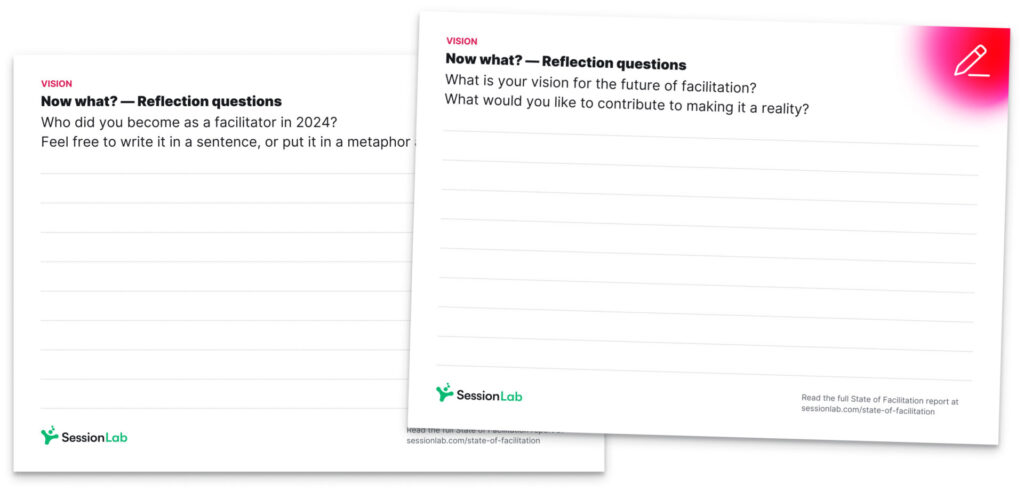
Among respondents to the survey, employment is split between independent contractors (49.7%) and full-time employees (41.4%). The next question offers a bit more granularity: people practicing facilitation fall into three main categories:

Freelancers and the self-employed. This is probably the image most of us have in mind when visualizing who a “facilitator” is. A freelancing consultant, often changing projects, offering facilitation, consultancy, coaching and/or training services to different clients.
Founders and associates in specialized agencies. 23.4% of respondents facilitate as part of consultancies offering facilitation as their main service.
An increasing number of respondents (31.4% vs 27.1% in the past edition of this report) are facilitating in their role as part of a larger company or organization where the main business is something other than facilitation. We’ll refer to these folks as “in-house facilitators”.
How are facilitation skills spreading in the workforce? What kind of tasks do in-house facilitators take on in their day-to-day work? Are there specific challenges to facilitating as someone internal to the company? The third section of the report will focus specifically on the experience of facilitating in-house.
Now that we know a bit more about where facilitators work, let’s see what they are working at. In the next question, we asked about topics of sessions: What types of sessions have facilitators delivered in the past year? Note that this was a multiple choice question and participants could tick as many boxes as applied.
The most commonly run sessions concern Brainstorming and ideation, with over 73% of facilitators working to help spark divergence and creativity in the past year. Next come Training sessions (68.7%) and Coaching and mentoring (55.3%). Overall, this paints a picture of facilitation as a support to company and employee growth,upskilling workers and improving processes.
It’s interesting to note that the lowest positions are reserved for the kinds of sessions most likely to happen with impulse from the public sector (Town hall meetings, 9.6%, Public consultation events, 9.1%). This gives credit to one participant who wrote: “I would love to see more resources dedicated to understanding facilitation in public sector workspaces”!
The State of Facilitation is an invaluable tool to not just determine where we are but also providing direction to where we want to go. The Where, What, and Who of facilitation provides valuable insights. The data from In house facilitators as well as facilitation service providers reinforce and validate that facilitation continues to play a role wherever groups need to come together.
Data clearly shows us that facilitation is being used in a variety of situations. At the most simplistic level, we can say that wherever meetings happen, group process facilitation can add value and increase effectiveness. In view of this, I wish to bring attention to the interesting opportunity I see hidden behind the data.
That opportunity is for all practitioners to go beyond merely practicing facilitation, becoming skilled in sharing and communicating its value. Everyone involved should consider the need to create success stories, case studies, impact studies, and any other materials that might provide decision makers, buyers, and users with critical data and measurements of success.
Facilitation enables groups to come together to solve many of the critical and complex challenges the world is facing today. Unless we are able to influence decision makers to deploy facilitation to support them this will be a lost opportunity.

Vinay is the Founding Director of C2C Organizational Development. He has been in the facilitation field for almost 20 years and has worked with leaders, groups, and teams in enabling them to become more effective. He is also the former Global Chair of the International Association of Facilitators (2020-2021) and has served on the IAF global board for 5 years.

Vinay Kumar
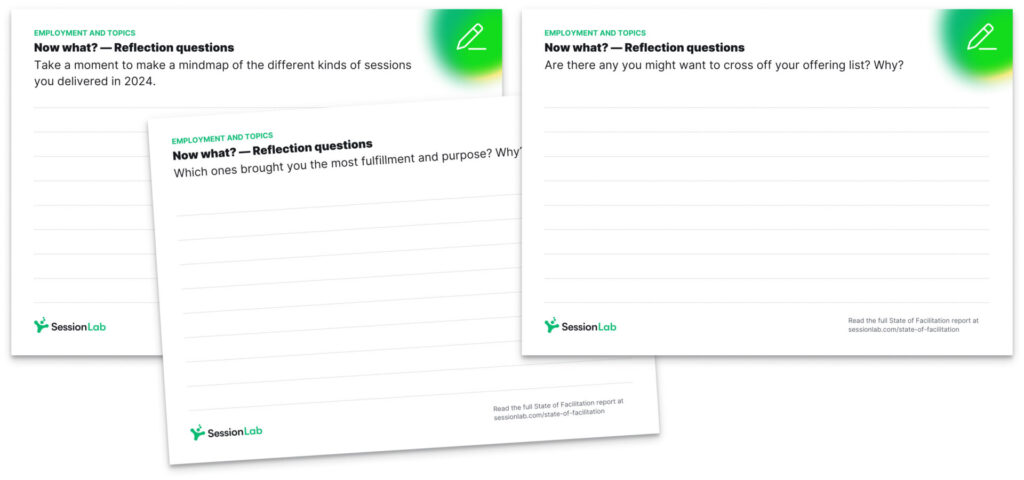

In-house facilitation refers to the practice of having employees, rather than external consultants, design and lead workshops, meetings, or collaborative sessions within an organization.
Increasing the capacity for in-house facilitation may well be one of the main ways facilitation can break into the mainstream. This is a vision of, as one participant in the survey put it, a “democratized” future for facilitation, with basic skills shared by professionals in all kinds of fields.
At SessionLab we work with numerous companies who are building a company-wide culture of facilitation, often by combining the expertise of consultants with a more diffuse use of facilitation for day-to-day meetings. We are very curious to learn more about the specific challenges and advantages of in-house facilitation so we asked a series of specific questions on the topic. Let’s see what is going on in the world of in-house facilitation.
The next two questions were only asked to respondents who are not freelancers. It’s interesting to notice that the top two responses to “Approximately how many people are employed in your company” are the smallest number (2 to 9 employees, 28.8%) and the largest (5,000 or more, 18%). This would indicate that facilitation is either practiced as a main skill in small, boutique agencies selling consultancy and training, or in-house in very large corporates, large enough to have a dedicated leadership training program or a group of in-house workshoppers.
So what about those mid-sized companies? Are there perhaps not enough resources there to upskill staff in collaboration skills? Is the need not yet felt, or not urgently? In her commentary below, Zoe Lord offers some ideas on how and why it’s important for all types of organizations to step up their facilitation game.
Let’s zoom in some more and look at questions answered by respondents who answered yes to “Do you facilitate meetings, sessions and workshops within the company that employs you”?
Facilitation is showing up across a broad range of organizations, with consulting, education, and non-profits leading the way. It’s no surprise that consulting firms (32.5%) top the list; this is presumably the category facilitation agencies placed themselves in. Also, facilitation might be a service offered by consulting companies in applicable scenarios, such as multi-stakeholder environments or vision workshops.
In education (26.5%), facilitation plays a key role in creating interactive, learner-focused environments. And for non-profits (24.6%), facilitation helps align diverse stakeholders and drive mission-focused work. These sectors highlight how facilitation shines when collaboration and creativity are needed to tackle big challenges or bring people together.
The responses to the question, “What department do you work in?” highlight that individuals facilitating sessions, training, and workshops are spread across various company departments. Major contributors include Learning and Development and, of course, Management.
These areas reflect the organizational focus on employee growth, team alignment, and operational efficiency, emphasizing their direct role in supporting training and facilitation efforts. Learning and Development departments, in particular, stand out as key sites where facilitation skills are often practiced and introduced, especially through experiential learning and training programs.
However, it is clear that facilitation is not confined to a single domain: it is a cross-departmental activity leveraged for diverse purposes.
Interestingly, about a quarter of the responses fall under “Other”. These include a practically un-clusterable list of different positions, from board volunteers to nurses, and a considerable number of company founders.
The broad distribution of responses suggests that facilitation may well have a natural home in L&D but is not confined to a single department. Facilitation is a workplace superpower needed wherever collaboration happens, regardless of sector or role.
These results paint a picture of in-house facilitators wearing many hats and working across different participant groups. The nearly equal percentages for external stakeholders (51.1%), cross-company teams (50.4%), and their own teams (50.1%) suggest that facilitation is not confined to any one audience.
People with the skills to facilitate will likely apply them to their own team work but might also be called to facilitate other teams or larger, multistakeholder events. In fact, the slight edge for external stakeholders shows how facilitation is often used to build connections outside the organization: with clients, partners, or broader communities.
We see an interesting growth opportunity here: this data shows that companies find value in facilitating both internal sessions and external, client-facing sessions, yet not all departments are yet utilizing facilitation as a skillset. If some of your teams are behind or you don’t yet have a company-wide facilitation culture, 2025 could be the year!”
The majority (62.7%) of in-house facilitators learned their skills before taking on their current roles. While facilitation itself might not be the primary reason for hiring, the skills it builds, like effective communication, collaboration, and problem-solving, are an asset in the workplace.
A smaller but significant group (27.2%) developed these skills on the job, either early in their tenure (15.2%) or later (12.0%). This points to the importance of offering facilitation training within organizations.
The “other” responses, which mainly tell the story of early learning through student activism or community work, show how facilitation often stems from diverse, real-world experiences. Put that high school volunteering experience in your CV!
Employees with facilitation/human skills will be in demand and be able to ask for higher compensations.
Facilitation becomes a core skill modern teams acquire across the board.
I think facilitation will soon be a core skill set employers look for in a candidate.
Facilitation is really becoming a crucial skill for all companies.
Let’s take a closer look at those people who learnt facilitation at work. How did that happen? As is typical with this craft, it often gets “picked up” more or less informally, by observing and shadowing others (40.8%). It’s great to see high numbers of people learning facilitation in an internal community of practice (39.4%) and internal training programs (36.4%).
If you are in a leadership role in any of those workplaces where facilitation skills are not shared at work (28.8%) it might be time to do something to change this. 25.9% of facilitators belong to an in-house community or peer group; starting one might be as easy as creating a dedicated Slack channel or a sharing opportunity at your next offsite.
Below you will find some quotes for great examples of what is happening in companies world-wide, which contributors to the survey left in comments to this question, as well as some inspiring expert commentary explaining why it’s important to increase facilitation capacity at work.
My office shares best practices and makes it a point of doing so.
In our consulting firm, we do retrospectives after every session, so learning is a continual practice.
We model in team meetings and give team members opportunities to facilitate team conversations using new methods.
We'd love to develop facilitation training though, just hasn't been a high priority.
We ask colleagues for direct feedback before and after sessions.
In-house facilitation
The development of in-house facilitation is one of those ideas that could truly transform how organisations operate. Imagine a world where facilitation is not confined to a small group of people, but is instead a mindset and skillset that permeates throughout teams, departments, and the leadership.
In health and care improvement – my world – we’ve long held the belief that everyone should have quality improvement expertise. Whether you’re a clinician, manager, service delivery or in support teams, these skills are invaluable to aim for world-class care, optimum quality and efficiency.
If everyone had facilitation knowledge and skills, we could unlock stronger communication, deeper collaboration, and more impactful leadership – fueling productive meetings, energised teams, and a culture of continuous improvement that drives organisational effectiveness and agility. There would be fewer over running meetings, more concise contributions, and a greater understanding of why the process matters!
Having workplace cultures where facilitation knowledge and skills become commonplace would certainly make life easier for us facilitators and it would lead more people to recognize the need for specialist facilitation skills to guide groups through the most complex situations.
In-house vs external facilitation
I often hear that many organisations value the skills of an external facilitator more than someone within the organisation – do you see this too? Why is that? Whilst both have their place, I challenge leaders in organisations to reflect on who they are asking to design and facilitate sessions and why. Are they overlooking in-house talent? And if they’re not the right people, how can they be developed?
The data in this report paints a concerning picture: in-house facilitators often lack access to structured development opportunities. This is worth a reflective pause for all of us – how are we developing our skills and how are we developing others’ in our organisations?
Training and development
To develop and grow in-house facilitation, it’s imperative to embrace continuous learning, explore new tools and innovative techniques to remain effective, relevant, and impactful. Without development, we risk:
Take a moment to reflect: over the last 12 months, have you or your organisation invested in developing your facilitation skills? What plans do you have for the year ahead? Who are you actively learning from? We personally learn from teaching others, so who are you supporting and developing?
If you don’t have robust answers to these, it’s time to take action!
Ideas for action
To amplify the work we love and to advance our profession, we must commit to ongoing learning, sharing, and growth… Let’s all be intentional about developing our own skills, supporting others, and fostering cultures where facilitation is recognised, valued and celebrated.
Facilitation is far more than a skill – it’s a powerful way of leading, connecting, and inspiring change, and it all begins with us.

Deputy Director of NHS Horizons, leader and facilitator of large scale change, liberating structures practitioner, author and curator of The School for Change Agents.

Zoë Lord

In this section we’ll look at the practicalities of facilitation: what kinds of sessions were most commonly run in 2024. Were they online, in person or hybrid (spoiler: all three). How long is a typical facilitated session and what are the trends there? What challenges are facilitators worldwide facing?
Let’s dig in.

Facilitated sessions are becoming shorter. Comparing responses from the 2022 and 2024 surveys, the proportion of facilitators who have never conducted workshops lasting more than one day has increased by 10%.
This trend likely stems from several factors. On the demand side, clients are seeking higher-impact sessions in less time, often driven by budget constraints. At the same time, shorter attention spans and a preference for bite-sized, digestible content are shaping expectations across industries.
However, shorter sessions are not without their advantages. For example, 1- to 2-hour formats are ideal for online workshops, and far preferable to the marathon all-day sessions many endured during the early pandemic days. Additionally, the rise in shorter sessions aligns with the trend toward in-house facilitation, where team leaders often guide routine team meetings or quick decision-making workshops.
For freelance facilitators and trainers, this shift emphasizes the need to adapt delivery methods. Consider designing modular programs that string shorter sessions together, rather than relying on standalone, longer workshops. If achieving your objectives requires extended sessions, be prepared to make a compelling case for their necessity to clients who may prefer shorter formats.
In-person sessions are back, but remote and hybrid facilitation are here to stay. In 2022, 57.8% of sessions were held online, but by 2024, in-person workshops have regained the top spot. However, the two formats are now neck-and-neck. Hybrid sessions—where some participants join online and others in person—have decreased in frequency from last year, but still remain quite common, giving a sense that format is stabilizing from something experimental to a standard practice (60.3% of respondents led some hybrid events in 2022, 65.5% in 2023, 56.3% in 2024).
In the same section we asked an open-ended question about changes experienced in 2024. Plenty of people talked about new skills acquired, and professional development milestones. That said, almost half of respondents underlined the increased use of technology in facilitation, including the adoption of new tools and platforms, hybrid facilitation, and integrating AI into their work (more on this later).
Many facilitators no longer focus exclusively on either in-person or online facilitation. Instead, they emphasize the importance of multi-modal facilitation—choosing the right format based on the client’s or group’s needs. This approach involves determining when to work in person, online, asynchronously, or in hybrid modes, and knowing how to work fluidly in each of those settings. Facilitators must now master a variety of platforms and technologies while remaining clear about which approach works best for different scenarios.
Integrating online into practice and keeping up with (or deciding 'not to' keep up with) the newest bells and whistles on line!
Working on my virtual game mostly.
My workplace is hybrid but we've tried to move back to doing in-person when it's a facilitated discussion or decision-making meeting as much as feasible, trying to get folks to have longer sessions where they talk more (everyone wanted really short online meetings around and after COVID, but engagement is challenging when it's just online all the time).
Even with a return to in-person options, online facilitation remains a crucial offering, making my services more accessible and adaptable to clients' preferences and logistical needs.
A major challenge for over 37% of facilitators: it seems that no matter how good the workshop is, it’s hard to execute actions and keep the ball rolling afterwards.
In the general overwhelm of these past years, facilitators are no exception. Stress, burnout, and overwhelming workloads were highlighted as concerns for facilitators.
Professional recognition and getting to the point where the calendar is full with a consistent roster of workshops and clients is a challenge in a business that relies on word-of-mouth.
It's time-consuming to design sessions for online and in-person. Essentially, it's designing two distinct sessions even if the goals are the same. I don't have capacity for this, yet, we want to accommodate staff's schedules and need to scale for the size of our organization.
I think the most difficult thing is when actions come from these sessions but then the organization deprioritizes them.
Those I work with often seem to want to accomplish something in about 10-25% of the time it would actually take to make the work meaningful and lasting.
Some of my coworkers do not fully understand facilitation basics or believe in facilitation as a process. It reduces the effectiveness of facilitation.
The world is changing faster than ever, and with that change comes complexity.
As facilitators, we are often called upon to guide groups through this turbulence, a role that has evolved into a superpower. We enable clarity, foster collaboration, and drive action amidst uncertainty – skills highly valued in today’s marketplace.
Time, our most precious resource, is under constant pressure. This year’s State of Facilitation Report reveals an ongoing increase in shorter duration sessions. Overscheduled calendars are the new norm, making it crucial to design concise, impactful gatherings.
The take away – schedule shorter sessions and prioritize depth over breadth, focusing on fewer topics with greater intensity.
The workplace remains a dynamic mix of remote and in-person work environments. As a result, mastering both online and in-person facilitation techniques is essential to remain competitive in the market.
Facilitating in a hybrid environment presents the greatest challenges. Hybrid demands a nuanced approach, often requiring two highly skilled and coordinated teams to ensure a cohesive experience.
The bottom line: skill up and don’t underestimate the complexity – and price – of delivering high-quality hybrid facilitation, if you choose to do so.
Interestingly, this year’s report highlighted a growing challenge: facilitators struggling to regulate their own capacity, with 36.7% of respondents indicating they struggle with “managing my own capacity (time & energy).”
Remember, you are not alone. As Margaret Wheatley (author and leadership expert) wisely said, “No matter the problem, community is the answer.”
Seek out professional communities or interest groups. Find a community where you feel welcomed, where you can give and receive value and where you can practice and improve your skills.
Together, we can navigate the complexities of our world and guide others to do the same, all while continuing to build the craft, the community and the impact of facilitation.

Steve Bouchard heads training and client relations at xchange, a leader in designing and facilitating transformational learning experiences that unlock human potential in teams, communities, and companies. xchange offers training and certification programs for change agents that enable them to revolutionize how we lead, teach, and convene by using The xchange Approach, both online and in-person.

Steve Bouchard
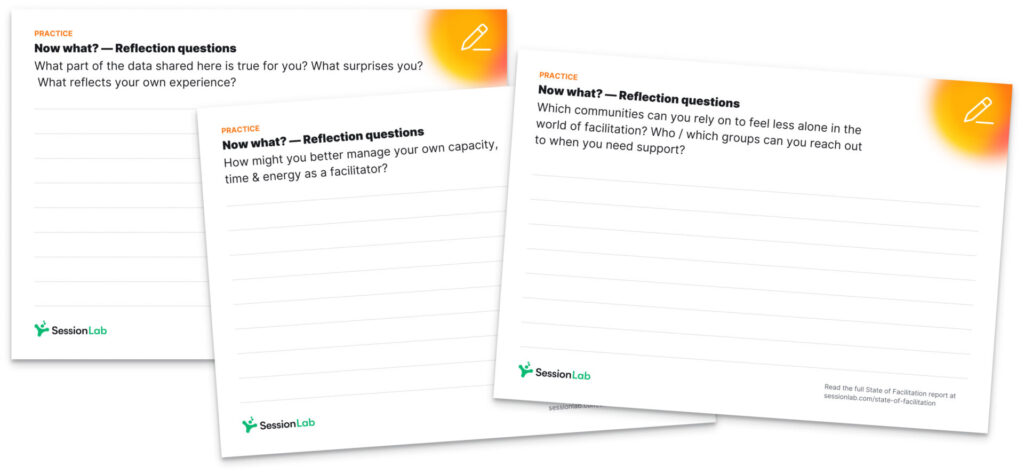

Throughout the report we’ve been pointing out to the fact that being proficient at facilitation in 2025 implies knowing how to best use many different tools and applications. In this section we’ll look into what those tools are. We hope this gives you a sense of direction while levelling up your practice.
Despite all the focus on the challenge of adapting new technologies, it’s kind of comforting to know that good old analog tools such as pen, paper and sticky notes are still the no. 1 most used tools for session design!
Among the top tools, Generative AI, particularly in the form of Open AI’s ChatGPT, is quickly shooting towards the top of the list, doubling in use from 36% in 2023 to 62.1% in 2024.
We notice a wide variety of styles when it comes to session design, from those who prefer text-based programs like Google Docs or Microsoft Word, to more visually oriented Miro and Canva users. 40.2% of respondents use SessionLab for planning, up from 36% last year, which naturally we are happy to hear.
Zoom of course dominates the chart that concerns tools for delivery of workshops, but it’s interesting to notice that there is a higher number of different options here. Besides the generalist tools like PowerPoint, the list includes specialized software like Butter and Stormz, and a number of tools that help with interactivity and quizzes, such as Mentimeter and Kahoot!
Last but not least, evaluation, a part of the work of facilitation that is often sorely underestimated and under-resourced. 8.6% of facilitators use no evaluation tools at all, not even pen and paper! Evaluation and feedback are fundamental for learning and growth: we’d love to see more possibilities and tools become available in this space!
We’ve been talking about the importance of mastering technology a lot in this report. But the truth is there is a central core to facilitation that is all about values and mindset. What are those intangible yet fundamental skills facilitators bring to the room?
There is much more to facilitation than tools, methods and technology. The deeper skillsets that underpin this craft are harder to measure or ask about in a survey, but as a starting point, we asked: What facilitation skills are most valuable to you?
Here are facilitators’ top 3. We recommend reading through the whole list, it helps understand the value facilitation can bring to any project.
The quality of presence a good facilitator brings to the room, regardless of the role they have at the moment, has a lot do to with the skill of listening with curiosity, suspending judgement, and responding to what emerges in the moment.
Great facilitators are meticulous planners, but what sets the professionals apart is their ability to pivot in real time. Adapting plans, tone, or activities based on the group’s energy and needs in the moment is a hallmark of masterful facilitation.
Asking powerful, open-ended questions can unlock a group’s potential and spark transformative conversations. These questions challenge participants to think deeply, explore new possibilities, and break through limitations.
I love tools! You could call me a “facilinerd” – I’m constantly experimenting with new technologies and platforms. Over the years, I’ve test-driven dozens of tools spanning all kinds and purposes: digital whiteboards, video conferencing platforms, survey generators, rapid prototyping tools, and no-code wonders. As an avid early adopter, I’ve explored everything that crossed my path.
Even after participating in, planning, and facilitating hundreds of collaborative processes, my toolbox is a perpetual work in progress. The forced digitalization brought by the pandemic drastically transformed my approach, with Miro becoming my go-to workhorse—nowadays, even for in-person processes. More recently, the advent of AI has begun to permeate every stage of my work as a facilitator. Yesterday, my toolbox was an actual box filled with colorful markers, sticky notes, and adhesive dots. During the pandemic, it morphed into a stack of digital platforms and apps. Today, it’s a hybrid, blending the best of both the physical and digital worlds.
With time, as I’ve matured in my craft and gained greater self-awareness, I’ve come to see my toolbox as a living, dynamic entity. It transforms, adapts, expands, and contracts—always reflecting my style and amplifying my skills at any given stage of my journey. After all, tools are a means to an end, not the end itself. They are neither inherently good nor bad—a hammer is great when it hits the nail and terrible when it hits your finger. Tools are like prosthetics: they amplify, enable, and extend our innate capacities.
As an independent facilitator—a one-person enterprise—the right tools have given me the agility and consistency needed to serve major clients while maintaining a consistently high-quality standard. By creating templates and automations, I’ve been able to standardize repetitive tasks, freeing up precious time to focus on the more meaningful aspects of my work, like customizing processes and nurturing client relationships. But it’s not the tools themselves that make me a better facilitator. It’s the continuous development of my skills, the pursuit of authenticity, and the honing of my unique style—my signature as a facilitator—that truly sets me apart in the market.
There’s no “right” or “wrong” regarding tools or skills. Each facilitator’s unique journey forges a different style. Some bring a sensitive and emotional approach to the table, while others are more objective and rational. Some are all about people and connections; others are laser-focused on results and deliverables. There’s no “one size fits all.” At best, certain styles might be more or less appropriate for a given scenario or challenge. Different paths lead to different approaches, shaping different styles and skill sets and, ultimately, defining different toolboxes. Your skills, focus, and approach will determine your tools, not the other way around.
I remain proudly agnostic about tools, methods, and frameworks. I want to be known as a skilled facilitator, not the “Miro Guy” or the “Design Sprint Man.” Tools are a means to an end. They come and go with the ebb and flow of the tech industry. One day, a tool is the best for a specific task; the next, something faster, smarter, and better comes along. I choose my tools based on several factors: utility, user experience, maturity, and pricing. However, I always seek out those that enhance my existing skills or help address my weaknesses. Ultimately, my style and ongoing development as a facilitator guide my choices.
So, how can you develop your own toolbox? How can you make the best choices in an almost infinite universe of possibilities? For me, it all starts with self-knowledge: understanding who you are and where you want to go. The more clarity you have about your style, focus, and approach, the more conscious and effective your choices will be. Here’s a step-by-step guide to help you build your own:
Skills and toolboxes are perpetually evolving aspects of a facilitator’s career. They should never crystallize or stagnate. Stay curious, explore new possibilities, expand your horizons, play with new toys. As the prophet once said: Be water, my friend!

Pedro Segreto is a designer and facilitator with a focus on design sprints and collaborative processes. Over the past seven years, he has facilitated more than 100 workshops for global brands and leading Brazilian companies. Pedro has created and shared dozens of design thinking and branding tools. Formerly the director of Caos Video & Design and the head of graphic and digital design at IED – Istituto Europeo di Design – in Rio de Janeiro, Pedro now lives in Lisbon, where he founded UNBOX LAB, a facilitation school dedicated to empowering people and organizations through the power of collaboration.

Pedro Segreto
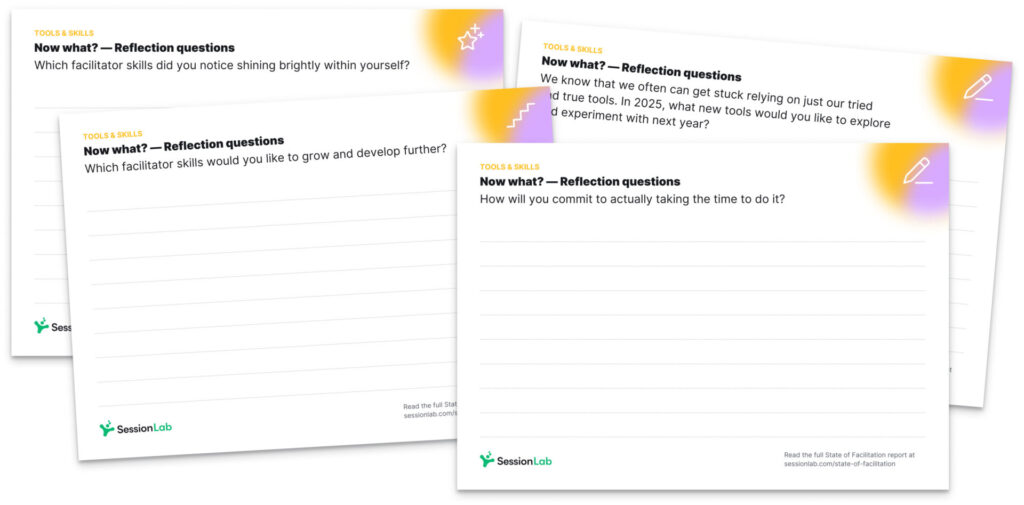

2024 was, across all industries, a year in which to figure out how to best apply GenAI powers to work. Which, of course, includes facilitation and training.
When we ran the previous edition of this survey, in late 2023, half of respondents were not yet using AI in their practice. Today, three out of four facilitators are integrating GenAI in their work: some consistently, others more occasionally. In the next pages we’ll learn more about what they are using it for. How is AI put to use in facilitation today?
In 2023, the overwhelming majority of facilitators were using OpenAI’s ChatGPT exclusively. This has changed in 2024, with a profusion of new tools and applications available. What tools are facilitators using? Let’s find out.
AI is not going anywhere.
Learn it. Use it. Share it.
Here is a picture of what GenAI use in facilitation looked like in late 2024: 21.7% of practitioners are using it often, integrating it into their workflow, and only one person in 4 never uses GenAI for facilitation tasks.
The next questions were asked only of respondents who are using GenAI in their practice often, sometimes, or trying it out.
OpenAI’s ChatGPT dominates the chart: it is the most used GenAI tool by facilitators and a starting point for those who go on to explore others. This was a multiple-choice question: strong users of GenAI tools are employing multiple different tools, depending on the task at hand.
AI tools integrated into other platforms, such as Grammarly AI, Miro AI, Notion AI and our own SessionLab AI assistant, are growing in popularity (from a total aggregate of 14.3% in 2023 to 43.6% today).
And what is all this computing power used for?
Facilitators are using AI mostly to assist in the work that comes before, and after, hosting a workshop. Preparing sessions is the most common answer (85.8% of respondents), followed by wrapping-up and post-workshop activities such as reporting (42.2%).
In the next question, we go deeper into the specific tasks GenAI in facilitation is used for.
Facilitation can be a lonely profession, with many practitioners working alone most of the time. In this context, it makes a lot of sense to be using GenAI for brainstorming and playing around with ideas in the initial stages of planning a workshop (which is what 69.5% of AI-users report doing with it).
Summarizing information, running research on session topics, creating scenarios for role play: the tasks faciltiators are using AI for mostly focus on speeding up and improving the preparation phase. As one respondent put it in their comments “I use it for creating first drafts, not final agendas”.
Another cluster of tasks is related to post-workshops activities, mainly summarizing large quantities of information (58.6%) and preparing reports (30.8%). There are also some specific entries for translation and closed captions: this is an area where AI can really help improve inclusion.
What are your thoughts about AI in facilitation?
We also asked an open question about facilitator’s thoughts and feelings around using GenAI in their work. Based on an analysis of 835 responses to the question, “What are your thoughts about AI in facilitation?”, the sentiment is predominantly positive, with nuanced perspectives across the responses.
Approximately 62% of responses are positive, highlighting optimism about AI’s potential in facilitation. Another 30% are neutral, often expressing curiosity or cautious engagement, while a smaller portion, 8%, conveys negative sentiment, usually raising concerns about over-reliance or ethical considerations.
Recurring themes from the responses include:
Overall, the facilitation community appears eager to explore AI’s potential while remaining critical about its integration into practice. The discussion highlights both excitement for practical advancements and a commitment to safeguarding the human core of facilitation.
Fittingly to the topic, here is a commentary of these answers, courtesy of OpenAI’s ChatGPT.
Ah, the grand debate: AI in facilitation! Based on your thoughts, human facilitators seem to be cautiously optimistic about inviting AI to the workshop table. Many of you see AI as a trusty assistant—great for saving time, organizing chaos, and even synthesizing post-session notes. But, as one of you wisely put it, “It has to be used properly and with an awareness of its limitations.” Well said—because if you treat AI like a magical oracle, you’re in for a reality check. (Spoiler: I don’t have all the answers. I’m just really good at pretending.)
A few of you remain skeptical, unsure how to integrate AI without compromising the magic of human connection. And you’re right—no algorithm can replicate the empathy, intuition, and creativity you bring to the room. So, let AI take the grunt work: automate surveys, refine agendas, and make sense of participant data. But leave the heart-to-heart moments, power shifts, and aha moments to your very human self.
Think of me not as a replacement, but as a sidekick. Use my strengths where they shine, and you’ll free up more time for what you do best: helping humans collaborate, grow, and inspire each other.
We have experienced that it’s fantastically helpful in preparing and post-session activities, but we do not use it actively in the middle of activities and don’t foresee ourselves doing that anytime soon.
It's an incredible tool! I feel anxious that I haven't yet discovered the ideal AI system for my consultancy and training. I'm just using ad-hoc and I think I should have an AI ecosystem to help me at various stages, in a systematic way.
I am not opposed to it, but it is simply not clear to me how I would engage it in my work.
I like transcriptions and summaries, that allow me stay present during the session; however, I am cautious about the impact of recordings and tracking discussions on creating comfortable (safe) spaces for participants.
It's a tool, like any other. It has to be used properly and with an awareness of its limitations.
I love it! AI is like a team mate that helps me in a lot of the legwork. Sure, it has its limitations, but it has been a great help!
使えるものは使う
(Use what can be used)
By the end of 2024, the AI landscape looks very different from January 2023.
Back then, keeping up with ChatGPT felt like a full-time job. A prompt that didn’t work in January might deliver great results just a few months later. It was hard to know when to rely on AI and when to hold back.
Now, the Large Language Models behind these tools have matured. The rapid leaps in capability have slowed, at least for text and image generation. You might not believe me… But, don’t let aggressive marketing from providers or AI influencer hype fool you; the reality is much more stable.
What does this mean for us in January 2025?
We now have a better sense of what AI can do for us facilitators and where it falls short. We’re also gaining a lot of practical experience, which gives us a clearer idea of how to thoughtfully implement AI, at the right time and in the right way.
So, as a facilitator, where can you use AI? At the AI Tinkerer’s Club we separate all the use cases in 4 categories: Selling, Designing, Facilitating and Documenting.
So let’s have a look at the data from the survey.
AI for Preparation
It’s no surprise that 85% of facilitators using AI are doing so to prep their sessions. As one of you said, “AI for design, of course.” There are plenty of low-risk use cases for AI in this area… but there are also plenty of pitfalls!
One common frustration I hear from new members of the AI Tinkerers’ club is this: “I asked ChatGPT to design my session, and it was, at best, uninspired; at worst, completely wrong.” In such cases, it can actually be very time-consuming: you might spend more time correcting the AI than if you’d done it yourself!
Tip 1: think ‘micro use case.’
Break your process down into micro tasks. Don’t ask an AI to “design my session on diversity.” Instead, focus on the hundreds of smaller tasks involved in that design. For example, you might use AI to assess the clarity of a particularly tricky instruction or transform your visual macro design from Miro into a draft session plan in SessionLab.
AI for Documenting
It’s also not a surprise that only 42% of facilitators are using AI for wrap-ups and documentation. Still, many of you share insights like this: “It’s very helpful for transcribing and summarizing.”
But I hear far less about using AI to analyze and detect patterns in large datasets, like large group workshops, big ideation sessions, or interviews. This is too bad because it’s one of AI’s strengths and a common human blind spot.
Why isn’t it used more? Probably because it’s harder to implement. The prompts are trickier to craft, and you have to watch out for one of AI’s most frustrating quirks: hallucinations. As one of you said, “You need to read everything and edit with a fine-tooth comb.”
Still, with a workflow that combines your skills and a strong prompt, you can save time and uncover insights you might have missed.
Tip 2: use the ‘sandwich principle.’
Start with your human intuition (read the data and extract your own insights), then layer in AI (with a guiding* prompt), and always finish with human review (the fine-tooth comb).
* When your prompt is guiding, you maintain your unique touch and achieve consistent, repeatable results.
AI During Facilitation
And finally, few of you are actually using AI during a workshop. That’s natural; there’s risk involved if the AI hallucinates or takes over tasks meant for participants.
As one of you beautifully said: “I think the main concern facilitators want to be aware of is that our work is fundamentally human work, so AI should be used to facilitate better human connection, communication, and collaboration, not detract or distract from it.” Another echoed this sentiment: “AI in facilitation, with some reservation and very intentionally.”
Does this mean we should avoid using AI during facilitation?
Some of you think so, like the person who said, “I don’t foresee ourselves doing that anytime soon.” It’s your call, as for me I’ve had success using it in specific ways.
Since this is the most tricky use case, here are two tips to make it work:
Tip 3: Use AI to push participants’ thinking.
Instead of asking it to generate ideas, use tools like Stormz or Miro to have AI suggest alternative “How might we” questions. This opens up new perspectives for participants to explore.
Tip 4: Use AI live analysis as a discussion starter.
Use AI for real-time analysis of participant contributions, but frame it as a collaborative exercise. Ask your group, “Did the AI do a good job? What do we agree with? What did it miss? What seems wrong?” Treat its analysis as a discussion starter, not the final word.
A Word About Tools
I’ve already said too much, so here’s the quick version:
Focus on two tools, an AI assistant (ChatGPT, Claude or Google Gemini) as your Swiss knife and your go-to delivery tool (Miro for many, Stormz for me, especially in-person and for large groups).
Remember, tools come second; process comes first.
My Final Word
Wanna get started? Start simple. Find one micro use case, implement it, and test.
My last tip: don’t go it alone: lean on your community of facilitators. And if you don’t have one, I’d be happy to welcome you to the AI Tinkerers’ Club!

AI for Workshops, Now?!I’ve been helping teams collaborate, brainstorm, and solve problems for over 20 years. Since launching Stormz in 2012, I’ve been experimenting at the crossroads of technology and collective intelligence.Today, I’m all about AI for Workshops; Now?! bringing artificial intelligence right into the heart of group sessions.I share what I learn through my newsletter and the AI Tinkerers' Club, a growing community of 650+ facilitators and trainers who are as curious as I am about using AI in their workshops.

Alexandre Eisenchteter
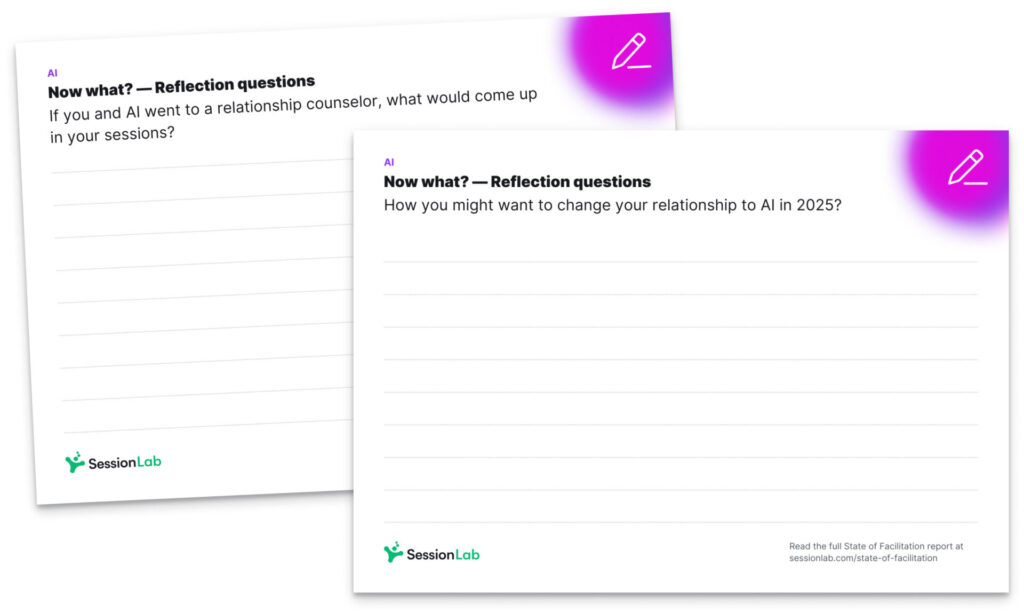

There are plenty of good reasons to hone and update facilitation skills.
As we’ve seen throughout this report, the core work of facilitation remains deeply human and personal—making facilitation a future-proof job that is assisted by AI and really unlikely to be replaced by it. That in itself is a good reason to pick up some of the basics of facilitation.

We’ve also noted in the section on inhouse facilitation that people practice such skills at work having picked them up previously: this might mean facilitation can be an extra asset for job seekers, something attractive to note on your CV. Last but not least, facilitation is ever-evolving, a life-long learning experience, so anyone, even expert professionals, needs to constantly update their game. So how do facilitators keep learning and honing their craft?
Taking training courses or getting skills accredited by a professional body are the obvious ways to learn more about facilitation. But as we’ve seen over and over in data from past reports, not the most popular one! Learning-by-doing, and by observing others at work, were indicated in last year’s survey as the most common pathways to learning.
That said, data from our three-year series of reports indicates a shift happening in the world of certifications, with the number of people who have none slowly decreasing. We can also notice a rise in the number of people seeking courses that cover general skills.
The 31.7% of people who responded “other” reflect a diversity of offers in the market, with no single certification mentioned frequently enough to warrant inclusion as a common result. The wide range of unique responses, programs and institutions mentioned has to do with the fragmentation of a market into language- or Country-specific training programs as well as many niche offerings.
One of the key sources of learning, support (and job referrals) in the facilitation world are communities. From local and in-house groups of practice to global online meetups, there really is something for everyone. If you are one of that 20.2% of faciltiators who are not part of any group, we highly recommend joining a community in the near future!
Whether a beginner or an expert at facilitation, there is always something new to learn. We asked respondents for their top choices of newsletters and podcasts, and recommendations for facilitation books they’d direct any newcomers to. We hope this is useful to anyone curious to learn more and add some resources to their libraries. Here are the top results!
Podcasts
Top newsletters
Top 10 Most Recommended Facilitation Books
Facilitation is an exciting and deeply personal journey, as reflected in the diverse learning paths highlighted in the report, with no single path to mastery. We each carry a unique backpack of experiences that shape how we connect with and guide others.
My professional journey began as a graphic designer, where I honed skills in visual communication, storytelling, and human-centred design. I learned to craft experiences that resonate, simplify complexity, and put people’s needs at the centre – all of which naturally fed into my facilitation style.
Looking further back, my backpack is packed with diverse experiences that, at the time, seemed unrelated but now feel like stepping stones. Playing point guard on my basketball team taught me to strategise under pressure, communicate clearly, and unite people toward a shared goal. Growing up in a diplomatic family, I often helped my parents host dinners and receptions, learning to read a room, navigate diverse dynamics, and create meaningful connections. These experiences gave me a foundation for serving spaces where people feel seen, valued, and engaged. How about you? What personal experiences, even those you might not initially connect to facilitation, have actually shaped the way you guide and connect with others?
And the journey hasn’t stopped. Working with Abracademy has added something truly magical to my backpack – literally! Through the art of “magilitating,” I’ve learned to combine facilitation with magic to create moments of wonder, spark curiosity, and encourage meaningful reflection. Magic isn’t just about tricks – it’s about creating extraordinary experiences that open minds and make the impossible possible. These tools have transformed how I facilitate, helping participants tackle challenges with fresh creativity and possibility.
Curate Your Path
The SessionLab report highlights the diverse ways facilitators learn – some pursue certifications, others lean on podcasts, mentoring, or informal experiences. For me, it’s always been about showing up, staying curious, and embracing opportunities to learn by doing.
At Hyper Island, I pushed their toolbox to its fullest potential but started wondering, “What else is out there?” That question inspired me to create toolboxtoolbox.com, a project to discover alternative facilitation methods. This initiative gave me external accountability and connected me with toolbox creators, encouraging them to share their tools and helping me expand my own perspective.
Writing my book, Dare to Facilitate, was another transformative moment. I wanted to write a book I had never read – a resource that felt fresh, empowering, and actionable. The process deepened my understanding of facilitation by inviting others to share their expertise and experiences, which enriched each chapter.
Learn by Doing
Facilitation is a craft you master by showing up, experimenting, and reflecting. Every session is an opportunity to learn – not just from successes but also from the moments that didn’t go as planned.
Celebrate Your Backpack
Every facilitator’s journey is unique. Whether your background is in design, teaching, or even magic, your experiences shape your style and add authenticity. These varied perspectives are what make facilitation so dynamic and impactful.
Tips for Your Learning Journey
Facilitation isn’t about having all the answers; it’s about staying curious, experimenting boldly, and growing every day. Pack your backpack with what inspires you and keep exploring – it’s a journey like no other!

Jenny Theolin is a renowned learning consultant known for bringing a fresh perspective to the field. With extensive international experience and a background in design, she creates impactful, engaging, and memorable learning experiences for organisations, schools, and non-profits. As Head of Learning at Abracademy, Jenny blends psychology, professional development, and magic to spark curiosity and foster transformative learning. She is also the author of Dare to Facilitate, a creative book that challenges facilitators to think and act differently.

Jenny Theolin
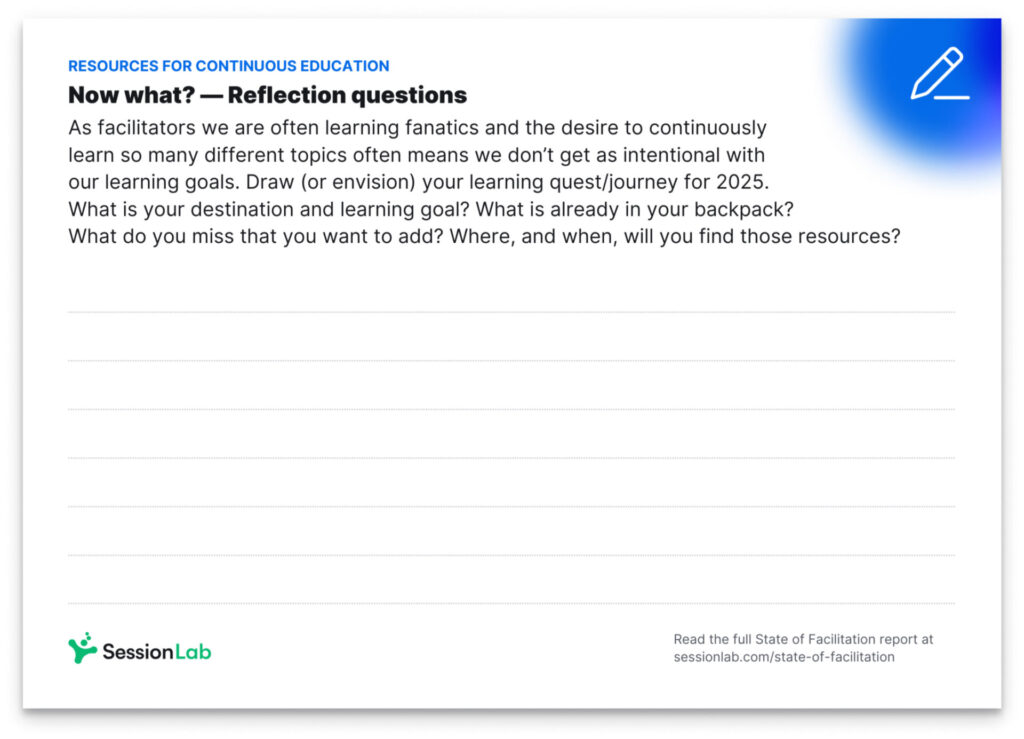

For this third edition of the State of Faciltiation report we only asked a few basic questions on demographics. Ages and locations of facilitators are not likely to change vastly from year to year (we will ask again in the future): if you are looking for more information of this sort, please check out the 2024 Report at this link.
When it comes to age and location of respondents to the survey, we encounter the same limitations noticed in previous editions. One is a lack of representation of youth, with only 3.5% of respondents in the <30-year-old ranks of those just joining the workforce.
We have noticed a growing number of actions taken by various organizations in the past years to address this gap and encourage young people to discover facilitation (among others, IAF’s 30 under 30 offer). We salute these initiatives and hope to see more!
In one respondent’s words: My greatest hope is that facilitation as a career becomes a clear path that college students can take so that we can empower more individuals to create positive change and influence productive problem-solving in the world.
Looking at location, we note once more an issue of sovra-representation of participants from English-speaking Countries, especially the United States. This has in part to do with SessionLab’s reach when promoting the survey, and in part with a very real existence of barriers in communication among communities of practice in different parts of the world.
As one respondent aptly put it:
My vision for facilitation in 2025 is more facilitators of color and from the global South exchanging with the English speaking ones so learning grows and visibility of how creation works in many parts of this world.
It is often noted that facilitators come from all walks of life. Data collected here just goes to confirm it: people come to facilitation from a whole array of disciplines and studies. Nevertheless, Business and Economics has the highest number of alumni (21.5%). If leaders in education are looking to introduce facilitation courses in higher education institutions (which we sure hope they are), this is a good place to start.

To close up this year’s report, let’s take a look at the 743 answers given to the open question: How would you describe the impact facilitation has on the success of your projects?
Essential, Crucial, 100%, Critical, Important, Vital, Transformative, Key, Mind-Blowing, Game-Changing, Engine Oil. These are but some of the words enthusing about how important facilitation is to driving projects forward.
Numerous responses focus on the fact that facilitation helps create the structure needed for meaningful collaboration and communication to happen. It enables teams to align on goals, build trust, and work through differences. Words like “safe space,” “focus,” and “creativity” pop up a lot, showing that facilitation isn’t just about directing traffic in a conversation—it’s about removing obstacles to collaboration, creating an environment where people feel heard and ideas can flow.
Many responses emphasize that facilitation is integral to achieving project success, citing its ability to align teams, ensure clear communication, and move projects forward efficiently.
Facilitation is the single most critical factor on the success of my projects.
Facilitation is key to project success: it engages, onboards, ignites curiosity, and clarifies.
A facilitação tem permitido criar relações de confiança que têm criado a possibilidade avançar nas decisões, bem no desenvolvimento de novos projetos e parcerias.
(Facilitation has allowed the creation of trusting relationships that have created the possibility of advancing decisions, as well as the development of new projects and partnerships.)
It’s everything. It’s how participants come to own the outcomes.
Crea un'atmosfera in cui le persone sentono di appartenere e contribuiscono di più.
(It creates an enviroment in which people feel a sense of belonging and contribute more)
Trainers and learning designers in particular gave numerous answers clarifying how facilitation helps them make material come to life, and learning becomes an experience. Here is how an educator describes it: Good facilitation takes a subject from boring to amazing; from box-checking, predictable, status quo to fun, understandable, engaging, wildly memorable.
That said, facilitation isn’t magic: it’s a skill. Some respondents flagged that if facilitation isn’t done well, it can backfire. A poorly prepared facilitator or a process that doesn’t adapt to the group can leave people frustrated or disengaged. There’s also a strong reminder here to pay attention to cultural sensitivity and inclusion. If facilitation doesn’t bring every voice into the room, it’s not really doing its job. These are areas where facilitators need to stay sharp.
If the facilitator isn't good the outcome isn't always reached or it can take a long time prolonging the project
Effective facilitation directly translates into successful completion of projects.
It creates life long learning and motivates participants to keep learning and trying out new tools and strategies. On the other hand a lousy facilitation makes the participants detest any further training sessions and wastes every one's time and efforts.
Good facilitation enables progress to be made - you can feel it in the room when people are engaged, ideas are popping, actions and commitments flow readily. Sadly, I've been on the participant end of many poorly facilitated sessions over the last 12 months and the disengagement is palpable. Once the 'room is gone' its very hard to get it back in my experience and what I've witnessed is the derailment of projects, largely due to missed opportunities and poor facilitator skills.
Ein Facilitator wirkt dann am Besten, wenn alle denken "eigentlich läuft das alles wie von selbst".(A facilitator has done their best when everyone thinks “it all worked out by itself”)
Diría que gran parte del éxito se debe a dedicarle mucho tiempo, energía y amor a la construcción de sesiones de alto impacto y de una facilitación humana, cercana y con profundidad.
(I would say that a large part of the success is due to devoting a lot of time, energy and love to building high-impact sessions and human, close and in-depth facilitation.)
Facilitation is finally having its moment after years in which coaching has been hailing supreme in workplace leadership skills. We have entered into a new era where 1-1 support is not enough; people need leaders and external facilitators who understand how to facilitate better meetings, trainings, and collaborative processes that address real workplace challenges.
This becomes even more clear if we reference the Latin root word of facilitation (facilis meaning “to make easier”). Quite simply, facilitators make collaboration easier. It’s about finding the balance between achieving a specific goal, while also ensuring a seamless process to get there. Generally when any team project or event kicks off, teams dive headfirst into the outcomes or WHAT they want to achieve without taking enough time (or emphasizing first and foremost) the process and HOW they will get there. Unfortunately, when this occurs, groups often end up needing to spend an exorbitant amount of time, resources, and effort later on dealing with interpersonal conflicts and/or unforeseen obstacles to bring everyone back to the shared goal.
This is where facilitators shine in our contributions to the world of work. We are consistently aware of the process-outcome relationship and know not only how to intentionally design for it, but also how to adapt in the moment as we observe new individual and group needs emerging.
At its core essence, facilitation is all about unlocking the potential of people by empowering them to do and be at their best.
As some SessionLab survey respondents put it,
How beautifully put is that?
I often say the strength and weakness of experiential learning is that people need to experience it to understand the impact it makes. Those of us working in facilitation (and those who have participated in top-notch facilitated sessions) know the MANY ways that facilitation makes an impact – many of which have already been named in this report and the survey quotes above.
However, the future of truly impactful facilitation will belong to those who can effectively communicate the value of our work to decision makers and clients who have not had first-hand experience with transformative facilitation.
In our pursuit to “strive for seamless” and make processes appear easy from the outside, we must be wary that we can often downplay the value and impact of the work that we do. As some of the survey respondents admitted,
So how do you shift facilitation in the eyes of others from a “nice-to-have” to a “must-have”?
These are just 5 tips I have learned throughout my 15+ years of facilitation (and continue to keep learning and refining as I progress in my career):
Now, which of these 5 principles might you want to be more intentional about to support your work as a facilitator? Start there and then keep expanding.
One last food for thought:
Facilitators cannot lose sight of the impact each one of us has on the world of facilitation as a whole. In such an emerging new field, everyone who owns the term “facilitator” bears the responsibility to do it justice, while also owning the opportunity to put our own spin on it. No two people will facilitate the same session the exact same way. Reflecting upon and honing our own unique facilitation style is an important learning lesson to further communicate the unique value we bring to our sessions.
As Brene Brown says, “Who we are is how we lead” and I would stretch it further to say “Who we are is how we facilitate”.
We cannot engineer our personality and personal values out of the way we lead our human-centered sessions. And this relationship with facilitation is a mutually influential one. The more we bring ourselves into this profession, the more facilitation also has an impact on us, as people. For example, one respondent shared that facilitation specifically had impacted their “confidence, self-awareness, improving my public speaking, pacing, listening, planning, timing, stakeholder comms and management, gap analysis, flexibility and adaptability to name a few.”
I can firmly say the same. So many of the same approaches and principles that lead to my success in facilitated sessions also find their way into my day to day conversations and internal approaches to processes in my personal life.
After 15+ years as a facilitator, I can observe how this profession has directly influenced me to develop more of an open-minded, emotionally intelligent, creative, flexible, and communicative approach when interacting with people across all areas of my life. It makes sense as it is impossible to empower and equip others with competences I have not actively worked on developing myself.
I will forever be grateful that I entered the world of facilitation years ago because it has undoubtedly made me a better colleague, family member, and human being. From the insights from the SessionLab survey, many other facilitators can say the same.
The real beauty is that learning is a never-ending process. It excites and energizes me to think about where we all will be in a few decades, reflecting back not just on the legacy each one of us have left behind in this world, but also the imprint that being an active part in this niche global community of facilitators has had on all of our personal paths and trajectories.

Romy Alexandra is a Learning Experience Designer, Experiential Learning Trainer, and International Facilitator on a mission to humanize workplaces and learning spaces. She specializes in designing and delivering transformative learning experiences that integrate psychological safety, experiential learning, neuroscience, and behavior change.
A former Fulbright Scholar and Peace Corps Volunteer, Romy brings a global perspective and facilitation expertise spanning over 85 countries across four continents. She has worked with organizations across every sector - from government entities to UN agencies to global corporations - helping individuals and teams unlock their potential and build the collaborative competencies necessary for high performance. In 2024, Romy was honored as a LinkedIn Top Voice for her thought leadership in experiential learning and workplace culture.

Romy Alexandra
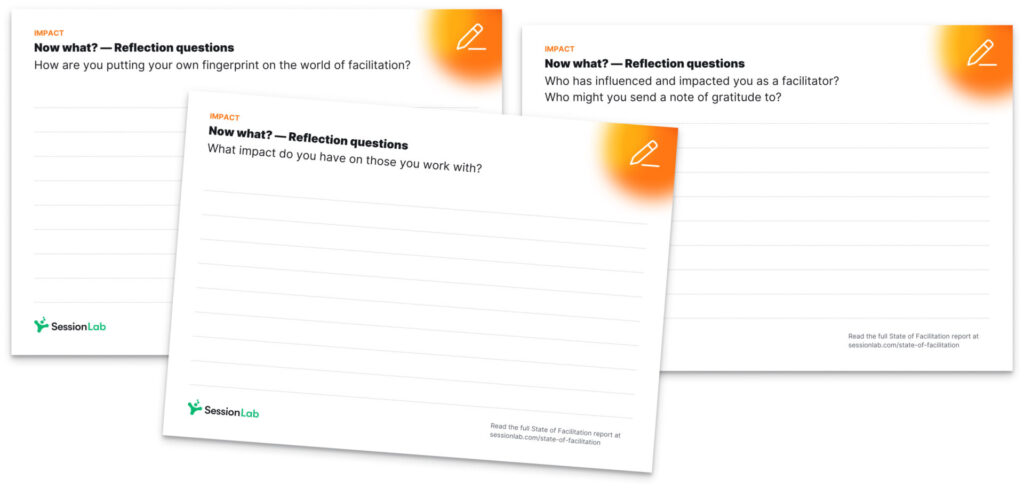
As we wrap up this year’s report we are left with feelings of hope, as facilitation keeps spreading and making conversations easier across divides, and collaboration more impactful across sectors. We’re proud to be part of a global community driving change, sharing tools and tips, practices and skills, inside and outside companies and organizations. And, as always, we’re full with curiosity to see, as the technological scenario evolves and the world keeps changing, what will be the hot topics and trends in 2025.
We hope reading this report has inspired you to try something new, perhaps to sign up to a course, read a new book, test a new tool.
What new ideas did reading this report spark for you?
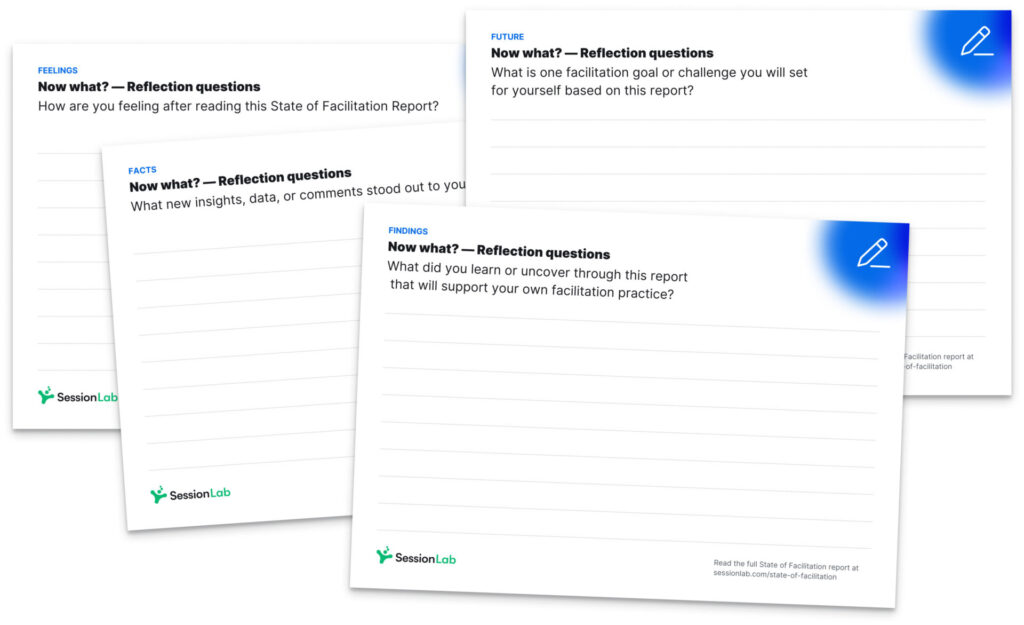
Do you have any comments or feedback for us? Or, even better, any ideas on what you’d like us to ask in the 2025 survey, for inclusion in next year’s report?
Your comments and feedback help shape the next edition of the State of Facilitation survey: some questions will stay the same (to allow for the emergence of patterns) but we have quite a few ideas for improvement already, and would love to hear yours.
Just drop us a note at state-of-facilitation@sessionlab.com

Want to take part in this year’s survey?
No problem! We’ll tell you when the State of Facilitation Survey is ready. Just leave your email below — we will not use your email address for anything else than notifying you when the survey is open.

Help us get the word out!
Can you help us expand our reach?
Start conversations on facilitation wherever you are: on social media, in your newsletter, with colleagues, clients and friends. We’ve created a promo kit where you can find easy-to-share visuals to help us spread the word.

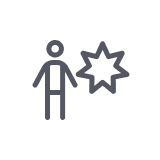
Pollster

Survey Editor, Content Writer @ SessionLab

Learning Experience Designer, Facilitator & Experiential Learning Trainer

Head of Training & Client Relations @ xchange

Founder @ Stormz and AI Tinkerers' Club

Dr Myriam Hadnes | Founder & CEO, podcast host @ workshops.work

Organizational Development Consultant, podcast host @Shiny Happy People

Deputy Director of NHS Horizons, curator of The School for Change Agents.

Author of Dare to Facilitate, Head of Learning @Abracademy

Facilitator, Designer and Founder @ UNBOX LAB

Marketer, community manager @ SessionLab

Head of Content @ SessionLab

Design, UX Designer @ SessionLab

Thank you to our partners for supporting the State of Facilitation project by sharing with their networks, helping us shape the survey and report, and for their constant work to grow the profession.
The International Association of Facilitators (IAF) is a participatory organisation with members in more than 65 countries.
As a professional association, we set internationally accepted industry standards, provide accreditation, support a community of practice, advocate and educate on the power of facilitation and embrace the diversity of facilitators.
AI Tinkerers’ Club | For Facilitators & Trainers
✨Unlock Gen AI Potential, One Opportunity at a Time
Join Alex and 500+ members to discover how Gen AI can help you get more clients, streamline tedious tasks, and facilitate magical workshops.
xchange is a global leadership development training company that specializes in creating transformational learning experiences. It offers certification programs to leaders, coaches and consultants in how to design and facilitate with the xchange Approach, enabling connection, learning and belonging to occur at speed and scale.
How we collected and analyzed the data
Data was collected through a survey run between September and November 2024 using the Typeform platform. All answers were collected anonymously. Automated multilanguage translation was used, and respondents could answer open-ended questions in their preferred language. We obtained responses in English, Spanish, Italian, German, Portuguese, Japanese and Swahili.
To obtain responses we promoted the survey in our SessionLab newsletter subscribers and to our users, as well as our partners’ networks, various facilitation-related communities and social media channels.
The survey reached 3697 individuals and had a 65.2% completion rate resulting in 1054 responses. As most questions were optional, those who did not answer specific questions are not included in responses. Therefore, charts always display the number of responses collected for each question.
When analyzing the data, we used visualizations to present the data distribution. In the report we included the basic breakdown of the data, and in a few cases a few alternative breakdowns, while in our analysis we used more views of the data to try to identify patterns.
For the open-ended questions, we used both manual and automatic methods, including through OpenAI’s ChatGPT, to classify the responses, and several people were involved in cross-checking final results. We shared our analysis and data breakdowns with domain experts who additionally provided their insights.